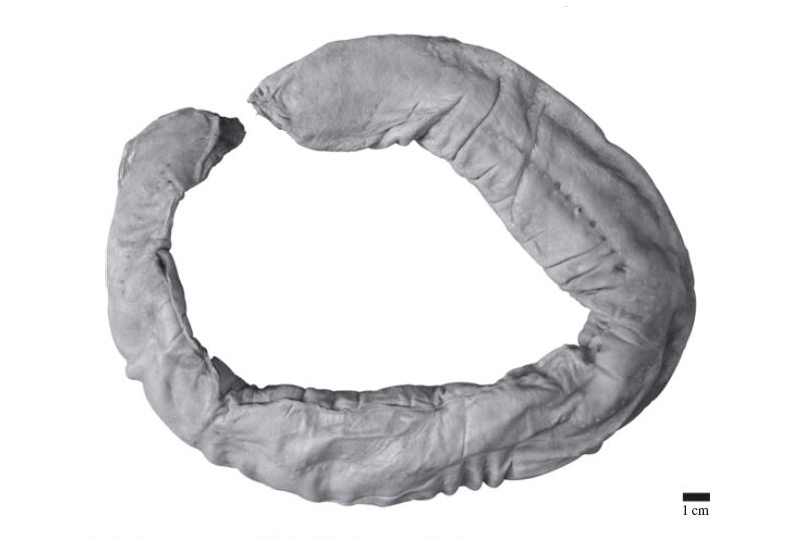- Classification
- MYXINI
- MYXINIFORMES
- MYXINIDAE
- Eptatretus
- strahani
Strahan's Hagfish, Eptatretus strahani McMillan & Wisner 1984

Strahan's Hagfish, Eptatretus strahani, from off King Sound, Western Australia. Source: Fig. 5 in Mincarone & Fernholm (2010) Journal of Fish Biology 77: 779-801. License: All rights reserved
Strahan's Hagfish, Eptatretus strahani McMillan & Wisner 1984
More Info
|
Distribution |
Northwest Shelf, near Rowley Shoals, Western Australia. Elsewhere the species occurs in the west Pacific (Philippines). Inhabits soft bottom areas on the continental shelf and upper slope. |
|
Features |
Gill pouches and apertures 7; fused cusps 3/3, total cusps 47-52; total slime pores 76-80. Ventral finfold well developed, readily visible; eyespots absent; ventral margin of tail forming a nearly straight line from cloaca to abrupt beginning of curve around tail; anterior few gill apertures small, slit-like; no pale rings around slime pores or gill apertures; trunk slime pores 45-53, high, near mid-lateral aspect; three fused cusps on each of the four multicusps. |
|
Feeding |
Hagfishes scavenge on dead or dying marine life, primarily on fishes and invertebrates, but also on marine mammals that have sunk to the ocean floor. They feed by rasping flesh with their horny teeth, often going completely inside sunken carcasses and feeding from the inside out. |
|
Biology |
Strahan's Hagfish lacks a copulatory organ. Hagfish gonads are in the peritoneal cavity - the ovary in the anterior portion of the gonad, and the testis in the posterior part. The animal becomes female if the cranial part of the gonad develops or male if the caudal part undergoes differentiation. If none develops, then the animal becomes sterile. If both anterior and posterior parts develop, then the animal becomes a functional hermaphrodite. However, hermaphroditism being characterised as functional needs to be validated by more reproduction studies. (Patzner 1998). |
|
Conservation |
IUCN: Data Deficient |
|
Etymology |
The species is "dedicated to Ronald Strahan in acknowledgement of his important contributions to the study of Myxinidae". |
|
Species Citation |
Eptatretus strahani McMillan & Wisner 1984, Proc. Calif. Acad. Sci. (4) 43(16): 262, Figs. 3(4), 4, 5(11). Type locality: South China Sea, near Lubang Islands, Philippines, 14◦00 N, 120◦18.2 E, in trap net at 189 m. |
|
Author |
Bray, D.J. 2018 |
|
Resources |
Strahan's Hagfish, Eptatretus strahani McMillan & Wisner 1984
References
Fernholm, B. 1998. Hagfish systematics, pp. 33-44 in Jørgensen, J.M., Lomholt, J.P., Weber, R.E. & Malte, H. (eds) The biology of hagfishes. London : Chapman & Hall, 578 pp.
McMillan, C B. & Wisner, R.L. 1984. Three new species of seven-gilled hagfishes (Myxinidae, Eptatretus) from the Pacific Ocean. Proceedings of the California Academy of Sciences 4 43(6): 249-267 See ref at BHL
Mincarone, M.M. 2011. Eptatretus strahani. The IUCN Red List of Threatened Species 2011: e.T196045A8997556. http://dx.doi.org/10.2305/IUCN.UK.2011-1.RLTS.T196045A8997556.en. Downloaded on 30 August 2018.
Mincarone, M.M. & Fernholm, B. 2010. Review of the Australian hagfishes with description of two new species of Eptatretus (Myxinidae). Journal of Fish Biology 77: 779-801.
Patzner, R.A. 1998. Gonads and reproduction in hagfishes, pp. 378-395 in Jørgensen, J.M., Lomholt, J.P., Weber, R.E. & Malte, H. (eds) The biology of hagfishes. London : Chapman & Hall, 578 pp.
Zintzen, V., Roberts, C.D., Shepherd, L., Stewart, A.L., Struthers, C.D., Anderson, M.J., McVeagh, M., Noren, M. & Fernholm, B. 2015. Review and phylogeny of the New Zealand hagfishes (Myxiniformes: Myxinidae), with a description of three new species, Zoological Journal of the Linnean Society 174(2): 363–393, https://doi.org/10.1111/zoj.12239, open access


